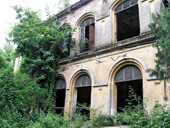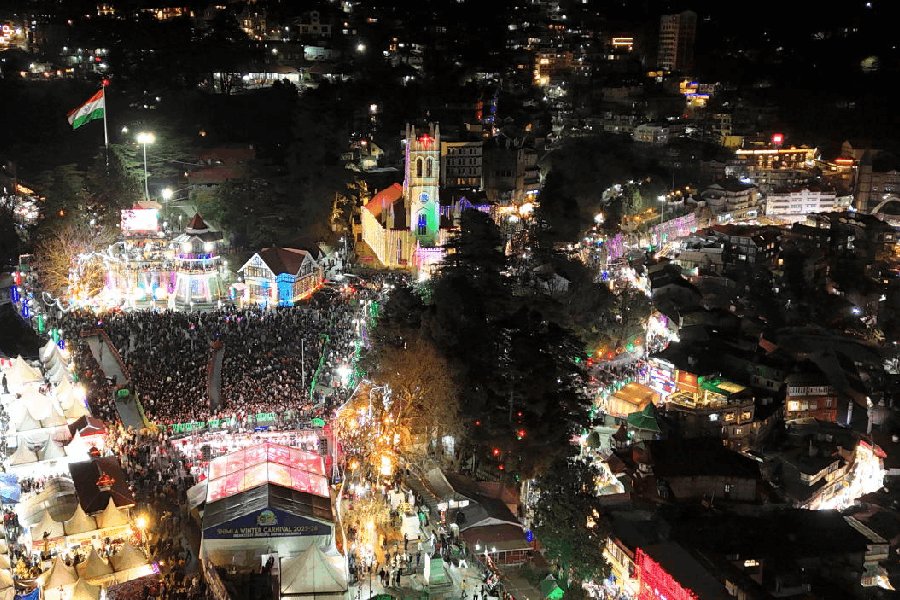 |
| Neechi Kothi side of the jute mill. Picture by Pranab Biswas |
Even the harshest critics of globalisation would admit that the Internet brings together people from all over the world faster than they could ever imagine even two decades before. About two years ago I had written an article on life in the jute mills that used to thrive in and around Calcutta from the 19th century till the late 1960s, most of which have added thousands of acres to Bengal’s vast industrial wasteland today. Just a year later, I received an email from one Jeff Clark in which he wrote that he had read the article, and that he retained “an altogether happy and quite vivid memory(s)” of Gouripore Jute Mill, near Naihati railway station. His father, who died in 2008 at the age of 83, had been employed here as an overseer /supervisor from 1948 to 1959.
Both he and his younger brother were born in Calcutta (“...I was in fact born across the river from Gouripur at the Angus Nursing Home. It was a wee hospital/nursing home which was part of the Angus Jute Mill/site...”) and were brought up in Gouripur till he was seven, prior to his family returning to Scotland in 1959. They were back in India in the early 1960’s when his father, Stanley Clark, worked in the same capacity for Ludlow Jute Mill in Chengail before returning to Scotland for good in 1967.
Thus began a year-long correspondence with Jeff Clark in which he gradually revealed how entire townships of Scotsmen and women co-existed quite happily, it seems, with their Indian colleagues and workers in these mills and factories only about half a century ago. Jeff along with his brother were boarders in La Martiniere, Calcutta, and a few emails later, we discovered that he had been a year junior to me in that institution. Earlier, they had attended Bandel Convent.
He sent scanned photographs of the Scots having a good time in Firpo’s along with Indian friends, of himself as a shirtless “baba” in the company of Indian servants and on the staircase of their bungalow, of a mixed race tennis group, of a group of men and women (mostly white) relaxing in front of a swimming pool, and of the stiff and suited Indian staff, some of whom Clark identified by name.
 |
He went on to describe his home: “At the side of our house was a grass tennis court whilst at the front and down was a wee-ish expanse of garden/greenery with trees which the malis tended to. Beyond that was a large untended wooded area…The Neechi Kothi had very spacious rooms but no A/C…coolish air was altogether punka-powered. There were three bedrooms, two bathrooms, living room, dining area, pantry (the kitchen/cooking, I think, was done outside in the backyard), and a very large verandah… Every birthday I had there was a wee bit of a burra tamasha on our verandah with kids from Indian and ex-pat families we knew. The likes of a biggish papier mache aeroplane full of popcorn and wee gifts would be suspended from the ceiling, and near the end of the party the bearer had great fun poking at it with a wooden stick until it broke open and it would all spill out to everyone’s delight.”
The officers did enjoy certain perks but they didn’t exactly live in clover. Jeff Clark’s father did not have a car of his own, and the jute mill employees had to work long hours. Manjul Mitter, 82, who had joined Macneill’s in 1950 and retired as director of the jute mill in 1979, spoke of times when Indian staff were in the ascendant both in the head office at 2 Fairlie Place (Mackinnon Mackenzie building) and the mills as the expatriates gradually started leaving the country.
For him, like most others, the day started at 6am and continued till 7pm. The labourers were absolutely under control in most mills. Once the management had to resort to “heavy retrenchment” for the introduction of wheelbarrows instead of loads being carried on the heads of coolies. But there was no unrest, he recalls. Once Mitter had to transfer a sardar to another department for talking back. The man chose to quit instead of suffering the humiliation of carrying loads on his head.
 |
| Jeffrey Clark on the steps of his home in Gauripore Jute Mill |
Mitter says most of the Scots were single men, and true to their alleged national character, many were stingy. Servants used to run their households and were accountable to their masters for every paisa they spent on provisions.
J.C. Ghosh, 85, a medical officer who had joined the mill in 1955, remembers the Scots as martinets (they abhorred malingers) who were quite fair as bosses. The Scottish officers would cycle around the mill just to keep an eye, and during Christmas and sports meets all the staff were welcomed by the memsaabs.
They say the “past is a different country: they do things differently there”, and while I was wandering about the wilderness of Gouripore Jute Mill last Tuesday I realised nothing could have been more true. For here on the banks of the Hooghly was an entire township without a soul in sight, complete with rows of jute godowns and clusters of buildings gradually being swallowed up by a jungle of creepers, shrubs and bushes luxuriating on the building walls, on the pathways, in a large hollow basin close to a jetty that extended to the river, and under the shade of giant peepul, krishnachuda and frangipani trees that grew all over the grounds. Aerial roots like giant hands had taken hold of these brick structures in their iron grip. It is difficult to imagine how the Scots had turned this terrain into their workplace and home.
In typical bungalow style of that period, the solid double-storeyed buildings were fronted by a series of arched verandahs and windows on floors. One of these was surely what Clark had referred to as Neechi Kothi. The louvres were mostly intact but the sunshades had crumbled. I walked up the steps of one building. The wooden staircase was whole but had been stripped of the balustrade. The newel post was lying on the floor. Two shiny plastic discs with Riddhi Siddhi printed on them were pasted on a door.
Deep inside this hinterland was the defunct thermal power station, limp red flags ranged out on top of its wall.
Nature seemed to be intent on reclaiming from grasping human beings what was rightfully her own territory. A large monitor lizard waddled across the pathway. The afternoon air was filled with strange cries of birds and critters and the angry hum of squads of bloody-minded mosquitoes.
The entire mill area — 560 acres — though is not totally uninhabited. And not just the coolie lines, which is in the last stages of degeneration. The families of two officers, whose dues are yet to be cleared, occupy a large double-storeyed building, which once housed the bachelors’ quarters and the club. Across the road leading to the river that runs through the mill area is what Clark and former residents call Tintalla kothi, behind which is the double-storeyed kitchen. Facing it are the servants’ quarters with a tiled roof. A handful of people live here too.
The mill, which opened in 1862, shut down in 1997 and 4,200 workers are expected to receive their dues in the near future. According to Subrata Sengupta, president of the Gouripur Mazdoor Bachao Manch, the high court on May 12 ruled in favour of clearing the workers’ dues and each of them could expect to be paid around Rs 1 lakh.
But not before several workers took their lives out of despair, says Paresh Sarkar of the Eastern Railway Men’s Congress.
Gouripore Jute Mills originally belonged to the Inchcape Group under Barry & Co. Later, in 1948, following amalgamation in 1948, MacNeill & Barry owned three jute mills — Gouripore, Nuddea and Ganges Manufacturing at Bansberia. Naihati bustled with activity owing to the presence of Jenson Nicholson, Gouripur Electric Supply and Container and Closures alongside what was the largest and best jute mill of those times. The jute mill stretching from Rishi Bankim Chandra Road up to the Hooghly has changed a few hands but all political parties are in agreement on one issue — they allege that industrialist Hemraj Mahabir Poddar is largely responsible for the current state of the mill, which has been under a court liquidator since 1997.
The mill may have closed, but like the metaphorical dead elephant it is still worth a fortune. Its assets are worth several crores and this is being plundered in broad daylight with the blessings of some local politicians and the police. Valuable equipment, electrical cable, both over- and underground, and other heavy copper goods — nothing is spared.











